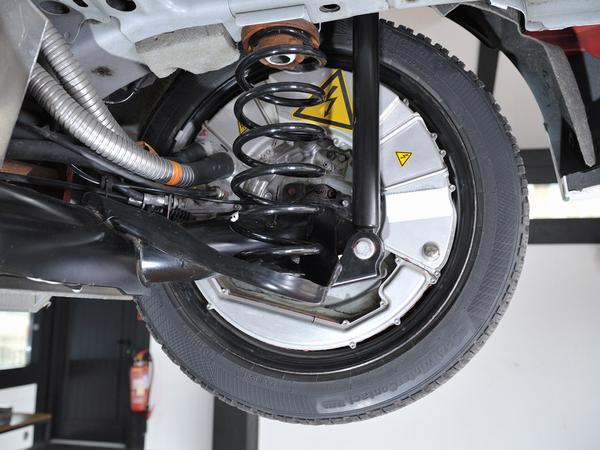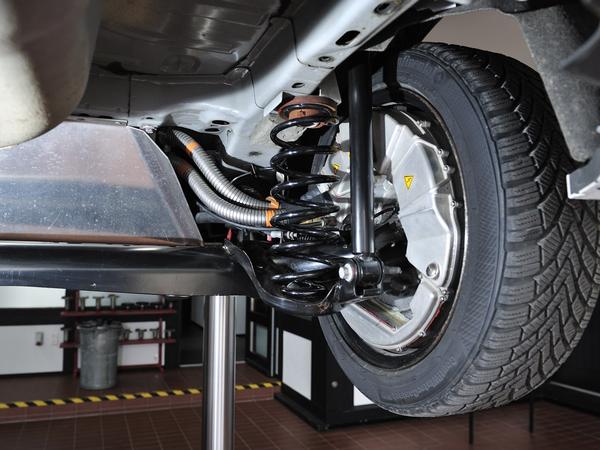What is an electric wheel hub drive? PH Explains
Looking for a drivetrain that's easy to assemble and package? A hub drive could be just the ticket

An electric wheel hub drive is an assembly that typically consists of an electric motor and braking assembly - all of which is attached to a vehicle's suspension and often fits within the confines of the wheel itself.
There are numerous benefits to such a configuration, including a tremendous packaging advantage as no conventional transmission or drive shafts are required. It's not all good news, though; in some cases, the unsprung weight of the assembly can far outstrip that of a conventional wheel and disc brake. Consequently, the ride and handling capabilities of the vehicle decrease.
Wheel hub motors are not common in automotive applications and are frequently confined to prototypes but they are used in industrial and commercial applications, such as electric buses. They can be of particular use in off-road applications, as the fitment of wheel hub drives can quickly grant all-wheel drive and torque vectoring - improving the vehicle's rough-road and manoeuvring capability. You will also commonly see them employed in electric bicycles.
As development of new electric drive systems continues apace, wheel hub drives may become more practical for use in cars; they would, for one thing, be ideal for a compact and efficient electric city car due to the packaging advantages alone.
Not that the concept is a new one, mind - electric wheel hub motors have been around since at least 1884. Ferdinand Porsche also made considerable use of hub drives, in the late 1800s and early 1900s, putting them to use in cars such as the hybrid Lohner-Porsche Mixte.

How do wheel hub drives work?
Wheel hub drives, also sometimes called 'in-wheel motors' or 'wheel hub motors', are assemblies that feature a bearing, a brake and the motor itself. In some cases, the module will also include the required power electronics to control the motor and its regenerative braking capabilities.
The rear of the assembly bolts to the vehicle's suspension, in most cases an upright, and usually contains the electric motor's coil assembly. The rotor of the electric motor, which rides on the central bearing assembly, bolts to the wheel. When the coils are energised, the magnetic fields generated cause the rotor to turn - driving the wheel.
There are several different variations on the hub motor concept, though, depending on the type of motor being used and its intended application. Manufacturer NSK, for example, has developed a hub motor that features two electric motors and an integral transmission. This allows the vehicle to more efficiently operate over a wider range of speeds, although the weight penalty is significant.
Some have gone even further. Michelin has previously showcased its 'Active Wheel' hub drive, which consists of a 40hp electric motor, disc brake and electrically driven active suspension set-up in one compact assembly that fits within the wheel.
The use of hub drives isn't restricted to the automotive market, mind, nor do they have to be electrically powered. In industrial applications, when significant power is required, hydraulically powered hub drives are often used in construction equipment or farm vehicles - although these obviously rely on an external source of hydraulic pressure, unlike the self-contained electric hub drives.
They can be used to grant trailer units motive power, too, making it easier to get them up steep slopes or across rough ground. Transmission manufacturer ZF makes electric hub drives for trailers and it also states that one further benefit is that they can permit the use of a smaller, more efficient tractor unit - which lowers running costs.

What are the advantages of hub drives?
One of the main benefits of using a hub drive is their space-saving capability. A vehicle designed to use hub motors requires no engine bay or provisions for a transmission. As a result, a manufacturer can vastly increase interior and storage space without making the car larger.
Because everything is contained within the hub assembly, building the car is also quicker and far easier. Similarly, the lack of driveshafts - in the case of front-wheel-drive applications - means that the turning circle can be dramatically reduced with ease. In conjunction with the ability to apply varying torque outputs at each wheel, manoeuvrability is often greatly increased. Need more traction for off-road applications? Simply fit four hub motors.
The lack of an engine and transmission means that safety is improved significantly, too, because in a frontal accident there won't be a heavy engine trying to force its way through the bulkhead. Removing the driveshafts and transmission from the equation could also reduce vibrations and noise in a wheel hub motor-equipped car.

What are the drawbacks of hub drives?
Despite the numerous advantages, there are also several prominent issues - cost and comparative complexity aside - when it comes to the use of hub drives. For starters, motors that can deliver both high torque and high speed are difficult to package without resorting to the use of a transmission - with heavy multi-gear assemblies such as those demonstrated by NSK protruding far beyond the wheel, countering some of the advantages of the technology.
The additional weight of hub motors increases the unsprung weight of the vehicle, too, which can decrease its handling capabilities and ride quality. Similarly, the packaging requirements of suitably capable motors and assemblies may require larger wheels - while the use of larger and more powerful motors require more complicated, heavy-duty power electronics. Again, all of this potentially serves to increase the weight of the assembly.
That said, some lightweight and compact prototypes have proven capable of delivering only minor increases in unsprung weight. Some, such as the Samsung 'eCorner' concept of 2006, have even done away with the need for hydraulic braking systems - with that particular concept adopting an electrically operated wedge-type braking system.
No increase in unsprung weight with this conversion apparently.
The environment it would have to work in is very hostile. Extreme vibration and impact loads, environmental exposure, and high temperatures from the necessary friction braking systems.
These aren’t issues for low performance factory/warehouse environment type vehicles, but for high speed operations out on the open road....very very different kettle of fish!
Gassing Station | General Gassing | Top of Page | What's New | My Stuff




